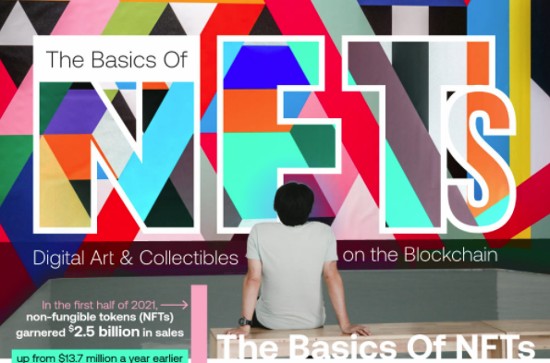Please welcome Brian Wallace, President of NowSourcing and a columnist for the Grit Daily and contributor to CommPro. Brian has been an avid reader of 21st Century Tech Blog and has offered to occasionally contribute new content to this site. He has also included a neat infographic to accompany his posting.
If not familiar with NFTs don’t be surprised if you start reading about them in newspaper headlines in the months to come. Recent transactions have netted the creators of these unique digital assets millions of dollars. So enjoy the read and please feel free to send us your comments.
NFTs are non-fungible tokens and they are selling for millions of dollars. In the first half of 2021, they garnered $2.5 billion in sales — up from $13.7 million a year earlier. To understand what is non-fungible, you need to know what fungible means. If something is fungible as an asset it can be replaced with something of equal value. But if something is non-fungible it is unique.
NFTs are akin to cryptocurrencies like Bitcoin. They are assets that are not money and yet are valued for their monetary equivalence. And NFTs are digital and secured by using digital keys, the same technology as cryptocurrencies. A public key serves to identify ownership and a private key authorizes any change to that ownership. While digital collectibles can be copied exactly, the use of blockchain (the open-source general ledger) provides secure and effective proof of ownership.
Any digital file can become an NFT. Here are some examples:
- For gamers, players earn, buy, or create new NFT game elements (checkout Axie Infinity, Gods Unchained, CryptoKitties).
- For sports fanatics, fans can buy, sell, and trade licensed video “moments” through the NBA’s Top Shot.
- For fashion connoisseurs, Nike patented tech that would give the owner of an NFT design the right to have it manufactured in the real world.
- In the music industry, NFTs can take the place of ticket sales or be used to sell albums of unreleased songs.
- And for philanthropic souls, NFT for Good offers marketplaces designed to sell digitized content for humanitarian causes.
But lately, the most common use of NFTs is in the buying and selling of digital art. The ability to monetize digital art has added significant value to this creative industry. Before blockchain, digital artists struggled to prove ownership of a piece of art and were unable to stop easily copied online content from appearing anywhere in the digital world without permission and without them receiving compensation.
When an artist creates an NFT, however, he or she can enable features that assign value to the art, pay for its use, and authenticate the digital file produced.
For a collector, ownership of an NFT conveys extra rights. Although anyone can download a digital file, only an owner of the file can sell it. NFT collectors can set an image as their profile picture or post it online, but most buy it as an investment, hoping its value will increase over time. The added incentive of profitability helps to ensure a digital collectible remains limited in circulation or one-of-a-kind. Ultimately its value depends on the artist’s ability to maintain its uniqueness.
NFTs are legitimate, but buyer beware. Chainalysis, a blockchain platform, estimates that 20% of all Bitcoin is locked up because the buyers have forgotten their private keys. That amounts to $140 billion in lost assets. Losing access can be as simple as forgetting a password, but once you’ve lost a private key, it’s unlikely you’ll get ever get it back. And buyers of NFT should be aware of hackers. In 2021 alone, hackers have stolen $600 million in cryptocurrency at the time of this writing through Poly Network amounting to the largest single crypto theft ever.
Whether a cryptocurrency or NFT purchase, owners must be vigilant about protecting the digital asset he or she has acquired. That means never storing private keys on a network-accessible device. If you’re considering an NFT purchase, watch out for doppelganger stores and crypto wallets, counterfeit collectibles and digital art, free giveaways, and NFT airdrops which are the most common scams and potentially devastating financially.
In the end, if you see NFTs as an investment of interest, and you have a high-risk tolerance, then this may be for you. Just remain cautious and vigilant. To learn more look at the accompanying infographic.
 Source: Expensivity
Source: Expensivity








